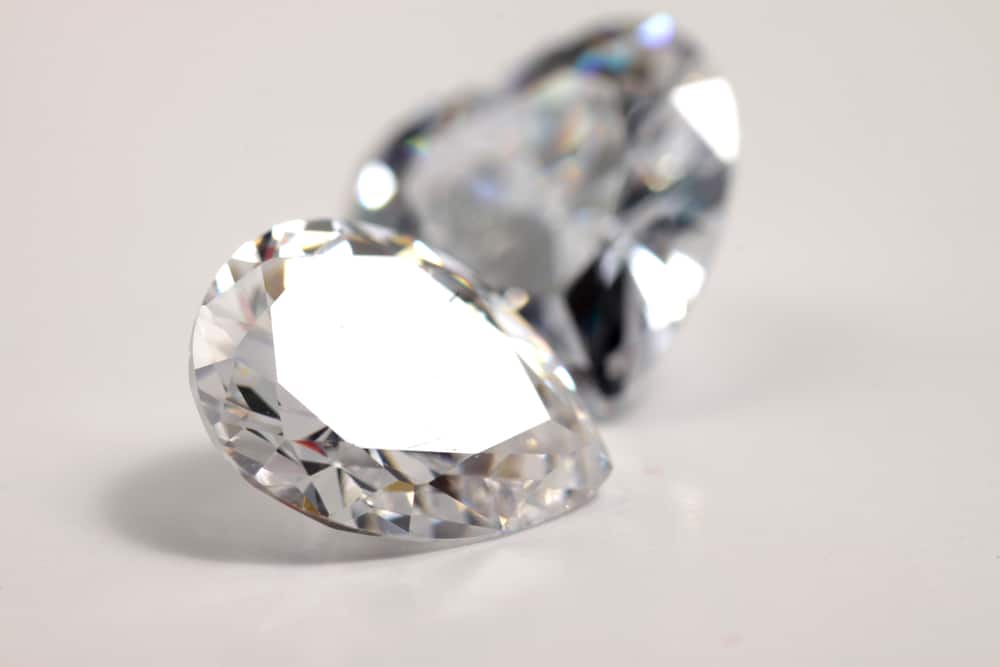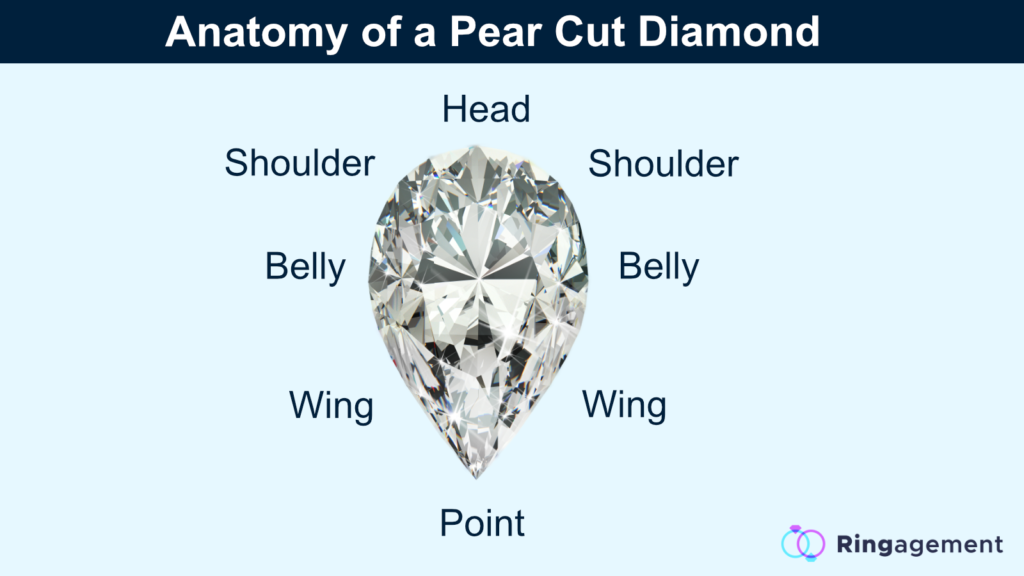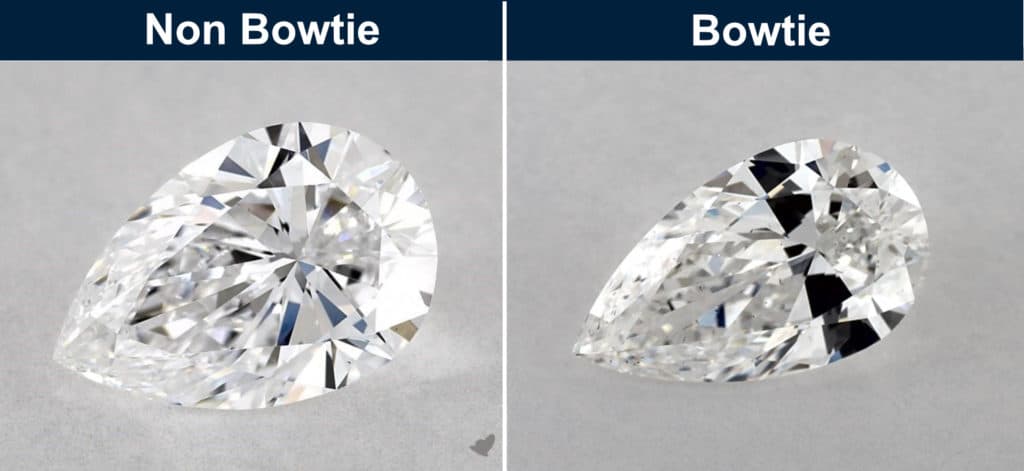As for my taste, Pear Shaped diamonds are the best of all possible worlds. The Pear Shaped Cut is:
- A brilliant cut which is more beautiful than Round Brilliant, in my opinion
- Less expensive than Round Brilliant
- Individualistic
- Mesmerizing
- Each Pear Shaped is more obviously unique than each Round Brilliant
Maybe it’s just me, along with other lovers of Pear Shaped diamonds, but this blend between a marquise shaped diamond and a round brilliant is the most pleasing shape possible.
What You’ll Learn
- What are the parts of a Pear Shaped diamond, and why is it important to know them?
- What should you look in a Pear Shaped diamond?
- What should you avoid in a Pear Shaped diamond?
- What’s a good color grade to aim for?
- What’s a good length to width ratio for a Pear Shaped diamond?
- Why is shopping for a Pear Shaped diamond simultaneously more challenging and more enjoyable?

What Are the Parts of Pear Shaped Diamond?
The first thing you should probably do as you get to know Pear Shaped diamonds is to learn the vocabulary for referring to the different parts.
The reason for that: With a Pear Shaped diamond, you’ll rely a lot more on your own observations than on anyone else’s observations or on a diamond certificate’s notations.
When you name something, you can see it better. This is why doctors study anatomy. Not so they know the latin names. But so they can see more clearly the human body, which they will make their life’s work to heal.
Fortunately, a Pear Shaped diamond is a lot simpler than that. You still want to be aware of how to look at one.
Shopping for a Pear Shaped diamond is a personal, subjective experience. So as you notice what you like and don’t like, you need to be able to give names to the various parts.
You also need to be able to understand what a salesperson or diamond guide is referring to.
Fortunately, learning the vocabulary is uber easy.

Parts of a Pear Shaped Diamond
Here are the parts of the pear cut diamond that you see above:
- The Head — The broad round end
- The Shoulders (2 of them) — The curve coming off the head
- The Belly (2 of them) — The curve, straightening out a bit, coming off the shoulder
- The Wing (2 of them) — The final straightaways, one on either side, toward the Point
- The Point — The sharp tip of the Pear Shaped diamond
What Should You Look for in a Pear Shaped Diamond?
Ultimately, you should look for what you like.
There are some commonly accepted guidelines that you too will almost certainly find correct and right for you as well.
Most of them boil down to good symmetry and proportion. Most of these depend on your eye, but some can be directly observed and measured and may appear on the diamond certificate.
Some Commonly Accepted Guidelines
- Symmetry — When you look at the diamond straight on, the shoulders and bellies and wings should mirror each other. The shape shouldn’t seem off.
- The Head — The head should be rounded and nicely formed, not too flat and not too bulbous in its outline.
- The Shoulders — The shoulders should not be out of proportion. Their lines should flow nicely.
- The Bellies and Wings should not be uneven. They should be slightly curved, not flat.
- The Point — The point should be sharp, but not too sharp. It shouldn’t be stubby.
- Brilliance — The Pear Shaped diamond is classed as a brilliant cut. Don’t expect quite as much brilliance as you can get from a Round Brilliant, but expect a fireworks show, especially in the head and table. The brilliance tapers off somewhat as the diamond does, toward the Point.
- Good Color that you like — A Pear-Shaped diamond doesn’t hide color as well as a Round Brilliant. With a Round Brilliant, you can choose slightly inferior color but the brilliance overwhelms the color, so that it appears to be colorless. Not so with a Pear Shaped diamond. Look closely at the point. That’s where brilliance is least, and that’s where you’ll be able to see the true color of the diamond.
What Should You Avoid in a Pear Shaped Diamond?
The things to avoid in a Pear Shaped diamond are pretty much the opposites of the qualities to look for.
Qualities to avoid include the following.
- Uneven shoulders, bellies, or wings.
- Off-center tip
- A culet (bottom) of the diamond which is off center. (A culet is just the bottom part of a diamond.) A diamond is 3D of course. The culet is beneath the diamond. When you look straight down into the diamond, you can see if the culet is in the middle, or whether it veers out toward one side. You want it as straight up and down as possible.
- Inclusions (flaws) that distract. Are any inclusions visible from the top? Depending on your budget, ask yourself, “Are they terribly visible?” If so, then you’ll want to move on.
- Table facet (the “top” of the diamond, in plain English) that doesn’t look right. Just as the culet (the bottom of the diamond) should be placed evenly, so should the table be placed evenly. Furthermore, the table should be perfectly level.
- “Bow-Tie” Effect — When you look down through the table (top), in some Pear-Shaped diamonds you’ll see the dreaded bow-tie effect. It looks rather like a dark bow tie running across the width of the diamond. It’s a trick of light — or in this case, of darkness.

Factors You Should Keep in Mind, but Not Necessarily Worry About
Here are a few other factors that may come into play when buying your diamond – that being said, they’re not necessarily the most important aspects of your diamond.
Color
Some qualities of diamonds are judged good or bad in a purely subjective manner, even though they affect price dramatically. I refer here mainly to Color grades.
Most people can’t see the difference between a color grade of F and a color grade of H, in the real world. Putting two diamonds side by side, the difference may become more clear.
But a slightly warmer color isn’t objectively a bad thing. Some people prefer it. (Some people even prefer Fancy Color diamonds, but that is indeed an outlier for Engagement ring diamonds.)
The higher prices in the D, E, and F colors are driven by people who have the money to spend and who will spend what it takes to get these relatively scarce diamonds. (You’ll remember that the most perfect colorless diamond is a “D”. No A, B, or C color designations exist.)
Why Do I Say Not to Worry Too Much About Color Grades With a Pear Shaped Diamond?
It’s up to you of course. You may still prefer the most colorless diamond possible, and that’s entirely right and good for you.
I think that with a Pear Shaped diamond, you’re already putting yourself a little outside the ordinary. It’s not a Round Brilliant. There’s no great mismatch in choosing a less than perfect color.
This analogy explains what I’m getting at:
- Round Brilliant diamonds are like tuxedos, you could say. There’s only one color which is perfect for a Round Brilliant (colorless), and only one color that’s perfect for a tuxedo (black).
- A Pear Shaped diamond is like a fine Italian suit. It’s not a tuxedo. It’s not meant to be. A Pear Shaped diamond is not a Round Brilliant. It’s close. But it’s not a Round Brilliant and is a little freer in what colors are acceptable. A respectable G or H is fine, in my opinion.
Length to Width Ratio
Pay attention to length to width ratios as a quality that you develop your own taste in.
But don’t go into the search with some expert’s strict range of length to width ratios that are considered “Ok” or “Not Ok”.
A smaller Pear Shaped diamond can have a longer length to width ratio. Otherwise the eye looking at it in the real world might not notice as well its flowing pear shape.
Length to width aesthetics also depend upon the thickness and length of the finger wearing it.
Point up or Point Down?
The point oriented away is more usual, but some Pear Shaped diamond engagement rings even have points oriented to the left or to the right.
It’s really up to you and your considered taste.
Opportunities for Individualized Beauty
The further away from Round that you go in Fancy Shape diamonds, the more opportunities you have for works of art in the settings.
- Halo settings can emphasize a Pear Shaped diamond is a beautiful way, as in this one from James Allen.
- This split shank rose gold setting is an amazing, creative, and eye-catching design.
Those two will give you just a small taste of what is possible. Enjoy exploring.
Pear Shaped Makes Diamonds New Again
Something about a Pear Shaped diamond engagement ring is so striking that suddenly diamonds seem almost new again — even to a diamond consultant who has seen thousands of diamonds.
A Pear Shaped diamond will always stand out. Just be sure to choose one carefully. People will look at it carefully, because it’s unusual and magnetic.
Shopping for a Pear Cut Diamond Can Be Challenging
- You have to watch for all kinds of little asymmetries, including the table and the culet.
- Also, little asymmetries are more visible than for example in a Round Brilliant Cut
- There are more possibilities for creativity and deviation from norms in Pear Shaped diamond cutting — and more opportunities for mistakes in cutting, or perceived mistakes.
- But when you see a Pear Shaped diamond that is nearly perfect in its symmetry, it really is rewarding — even if you don’t buy it.
The Main Quality to Look for Is Symmetry
Enjoy the pleasure of browsing many Pear Shaped diamond engagement rings. Two highly reputable retailers with a selection of Pear Shaped diamond engagement rings are:
- James Allen
- Blue Nile
Even if you don’t end up buying one, you’ll enjoy the window shopping. If you get hooked, then as you look, you’ll develop an eye for them.
You’ll get practice in spotting small asymmetries and inclusions, and things you like and don’t like about them.
Soon enough, you’ll find the perfect one.
If you want my help, or input, or even a quick answer to a quick question, don’t hesitate to contact me.
